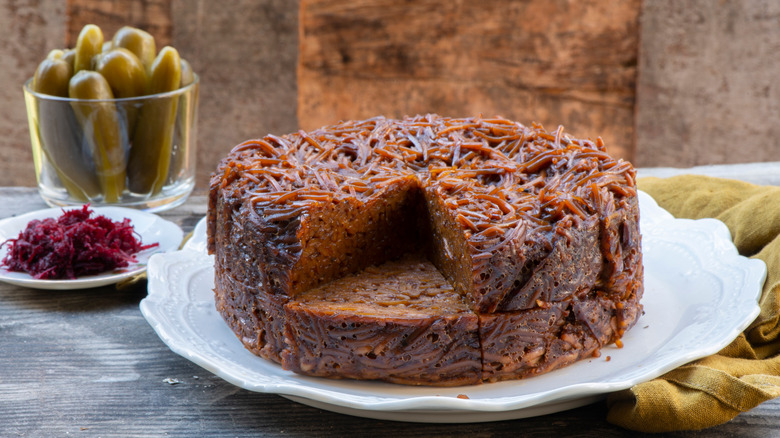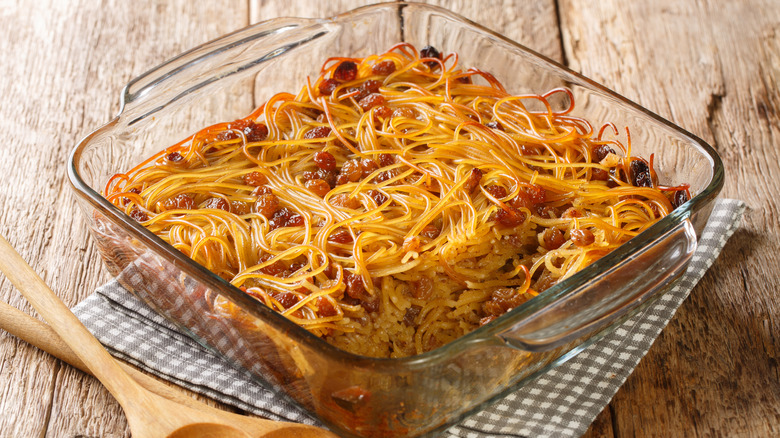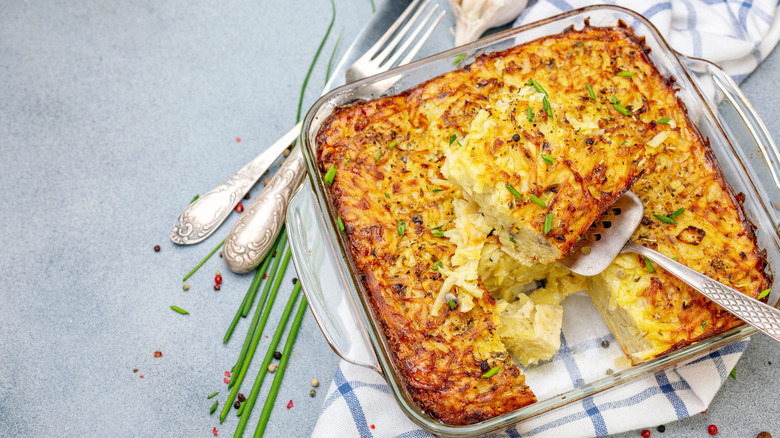What Is Kugel And Why Is It Typically Eaten On Hanukkah?
Kugel is a Jewish dish that dates back hundreds of years and has been vastly transformed since the early days of its preparation. Named for its original shape (kugel means "sphere" in German), the dish was made by placing a mixture similar to dumpling batter into a round cooking vessel called a kugeltopf before resting the entire dish in a pot of cooking stew for Shabbat. Over time, various other ingredients were added from garlic or onions for savory kugel to sugar or raisins for sweet kugel.
However, over time the recipe morphed into one baked in larger dishes and utilized lokshen (noodles) or potatoes instead of the dumpling-style mixture of its counterpart. While either ingredient can be incorporated into either a sweet or savory version, potato kugel is often savory and combines shredded potatoes with oil, onions, eggs, and sometimes cheese. Meanwhile, sweet noodle kugels are a custardy combination of pasta (often egg noodles) eggs, butter, sugar, and dairy like milk, cottage cheese, and cream cheese. Savory versions of noodle kugel omit the sugar and may incorporate other ingredients like cheese, onions, or vegetables. And at least one version, Jerusalem kugel, is both sweet and savory, incorporating caramelized sugar as well as black pepper.
While those standard styles kugel remain popular, there are nearly endless variations, as well. But why kugel on Hanukkah? Well, it boils down to tradition. For some, kugel appears every Shabbat, during the High Holidays, and during the lesser holidays — like Hannukah — too.
Why is kugel eaten on Hanukkah?
Many Hanukkah dishes like latkes and sufganiyot are fried as a symbol of the purified oil that burned for eight days during the retaking of the Temple. Even though kugel is a baked dish, there are multiple reasons for its inclusion on the table on just about every Jewish holiday you can think of. Not only is it often present during Hanukkah celebrations, it is often served on the High Holy Days of Rosh Hashanah and Yom Kippur, and is a staple for Shabbat meals. In Orthodox homes, cooking is not permitted on Shabbat, so having relatively shelf-stable foods ready is important.
For some, enjoying kugel on Hanukkah, as well as other holidays, may be a family tradition. However, the origin story of the importance of the dish runs even deeper than that. Based on his research, Allan Nadler, a professor of religious studies at Drew University, believes that the dish has meaning beyond sentimentality. He told the New York Times, "Clearly the spiritual high point of the meal is the offering of the kugel," in reference to kugel being served at a tish (Yiddish for table), which is a special meal where a rabbi is present. Some also say that the tangled pasta of the noodle kugel specifically has been said to be a symbol of Jewish unity – from the Ashkenazi to the Mizrahi.
Tips for the best kugel and what to serve with it
If you're making a noodle kugel, there are a few ways to make sure it turns out best. First, be sure to cook your pasta perfectly. Follow the package directions to make sure that you don't wind up with mushy noodles. Also, similar to other noodle casseroles (like lasagna) if you do not allow the kugel to cool before slicing it, it is bound to fall apart. And, while many kugels are served warm, don't be afraid to serve it cold, either.
If you're making a potato kugel, especially if you're making it ahead of time and storing it before baking, you may want to take precautions to prevent the potatoes from browning. To preserve the color of the potatoes, toss them with a little lemon juice. Also, covering the casserole dish with aluminum foil for the first portion of the cooking time will help to achieve just the right texture.
Once you've made your crave-worthy kugel, you can eat it all on its own or pair it up with nearly anything. Sweet kugels can be washed down with coffee and served with fruit or as part of a spread of other sweets. Meanwhile, savory kugels can serve as a side for other traditional Hanukkah dishes like brisket and latkes, or alongside any proteins, soups, or salads. And don't forget to put your own twists on it with added spices, veggies, or fruit.



